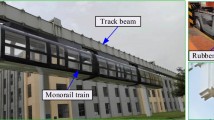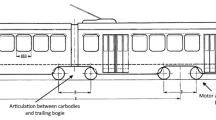Abstract
Since most tricycles are driven on rough roads, a static analysis of the frame with a constant load and a specific boundary condition is insufficient to assess whether the lightweight design satisfies the strength requirements. A flexible multibody dynamics approach is used to assess the dynamic stress of a tricycle frame in five driving conditions to determine the positions where material can be removed. The five driving conditions, including high-speed driving, turning, climbing, braking and driving on a bumpy road, are established according to two national standards. An electric tricycle prototype is modeled using the rigid-flexible coupling method, and experiments are conducted to adjust the center of mass and stiffness of the suspension. The frame stress results obtained from the simulation are in good agreement with the loading test results. Subsequently, the dynamic stress of the frame is analyzed, and a steel plate with a suitable thickness is selected according to the stress distribution and the allowable stress. The modified frame is about 19.1 % lighter, and the maximum stress is only 2.8 % larger than that of the prototype. The results demonstrate that the proposed method is suitable for the lightweight design of one component in a system operating under various working conditions.
Similar content being viewed by others
References
Addeplli, K. C., Remisoski, N., Sleath, A. and Liu, S. (2015). A multibody dynamics approach to leaf spring simulation for upfront analyses. SAE Technical Paper No. 2015-01-222.
Bein, T., Mayer, D., Hagebeuker, L., Bachinger, A., Bassan, D., Pluymers, B. and Delogu, M. (2016). Enhanced lightweight design — first results of the FP7 project ENLIGHT. Transportation Research Procedia, 14, 1031–1040.
bin Ab Razak, M. S., bin Hasim, M. H. and bin Ngatiman, N. A. (2017). Design of electric vehicle racing car chassis using topology optimization method. MATEC Web of Conf., 97, 01117.
Broek, C. T., Singh, H. and Hillebrecht, M. (2012). Lightweight design for the future steel vehicle. ATZ Worldwide 114, 5, 4–11.
Chandrupatla, T. R., Belegundu, A. D., Ramesh, T. and Ray, C. (2002). Introduction to Finite Elements in Engineering. 3rd edn. Prentice Hall. Upper Saddle River.
China National Standardization Administration Commission. (2008). Methods of road test for motorcycles and mopeds. China Standards Press. Beijing, China.
China National Standardization Administration Commission. (2017). Technical specifications for safety of power-driven vehicles operating on roads. China Standards Press. Beijing, China.
Cho, J. G., Koo, J. S. and Jung, H. S. (2016). A lightweight design approach for an EMU car body using a material selection method and size optimization. J. Mechanical Science and Technology 30, 2, 673–681.
Dutta, P. P., Sharma, S. Gogoi, T. K., Gogoi, R. and Das, A. (2013). Design and development of an improved hybrid tricycle. National Conference on Recent Advances in Mechanical Engineering. ISBN978-93-82880-71-4.
Freed, B. D. and Babuska, V. (1997). Finite element modeling of composite piezoelectric structures with MSC/NASTRNA. Smart Structures and Materials 1997: Smart Structures and Integrated Systems, 3041, 676–688.
Gadala, M. E., Elmadany, M. M. and Gadala, M. S. (1986). Finite element and analytical modelling of a tractor-semitrailer vehicle. Computers and Structures 23, 6, 831–836.
Gummer, A. and Sauer, B. (2014). Modeling planar slider-crank mechanisms with clearance joints in RecurDyn. Multibody System Dynamics 31, 2, 127–145.
Harušinec, J., Suchánek, A., Loulová, M. and Kurčík, P. (2019). Design of a prototype frame of an electrically driven three-wheel vehicle. MATEC Web of Conf., 254, 02014.
Kim, G. H., Cho, K. Z., Chyun, I. B. and Choi, G. S. (2013). Dynamic stress analysis of vehicle frame using a nonlinear finite element method. KSME Int. J. 17, 10, 1450–1457.
Kuratani, F., Matsubara, K. and Yamauchi, T. (2011). Finite element model for spot welds using multi-point constrains and its dynamic characteristics. SAE Int. J. Passenger Cars-Mechanical Systems, 4, 1311–1319.
Lee, J. S. and Cho, S. G. (2017). Study on torsional characteristics of the car body types at cornering motion. J. Korea Academia-Industrial Cooperation Society 18, 10, 739–744.
Lewis, A. M., Kelly, J. C. and Keoleian, G. A. (2012). Evaluating the life cycle greenhouse gas emissions from a lightweight plug-in hybrid electric vehicle in a regional context. 2012 IEEE Int. Symp. Sustainable Systems and Technology (ISSST), 1–6.
Marsili, R. and Rossi, G. (2017). TSA infrared measurements for stress distribution on car elements. J. Sensors and Sensor Systems 6, 2, 361–365.
Mucka, P. (2018). Simulated road profiles according to ISO 8608 in vibration analysis. J. Testing and Evaluation 46, 1, 405–418.
Patel, B. P. and Prajapati, J. M. (2012). Static analysis of mini hydraulic backhoe excavator attachment using FEA approach. Int. J. Mechanical Engineering and Robotics Research 1, 3, 163–175.
Patel, V. V. and Patel, R. I. (2012). Structural analysis of automotive chassis frame and design modification for weight reduction. Int. J. Engineering Research and Technology 1, 3.
Patil, R.V., Lande, P. R., Reddy, Y. P. and Sahasrabudhe, A. V. (2017). Optimization of three wheeler chassis by linear static analysis. Materials Today Proc. 4, 8, 8806–8815.
Rusiński, E., Harnatkiewicz, P., Kowalczyk, M. and Moczko, P. A. (2010). Examination of the causes of a bucket wheel fracture in a bucket wheel excavator. Engineering Failure Analysis 17, 6, 1300–1312.
Savkin, A. N., Gorobtsov, A. S. and Badikov, K. A. (2016). Estimation of truck frame fatigue life under service loading. Procedia Engineering, 150, 318–323.
Sun, H. Y., Wang, W. and Sun, L. J. (2009). Finite element method simulation of 35 # steel cathodic protection models in the seawater. Advanced Materials Research, 79, 1153–1156.
Tsai, M., Hong, H. J., Geisler, R. L. and Babiak, G. T. (2011). Dynamic vehicle durability simulation and applications using modal stress methodology. SAE Technical Paper No. 2011-01-0786.
Wang, D., Jiang, R. and Wu, Y. (2016). A hybrid method of modified NSGA-II and TOPSIS for lightweight design of parameterized passenger car sub-frame. J. Mechanical Science and Technology 30, 11, 4909–4917.
Yu, Z., Liu, Y., Tinsley, B. and Shabana, A. A. (2016). Integration of geometry and analysis for vehicle system applications: Continuum-based leaf spring and tire assembly. J. Computational and Nonlinear Dynamics 11, 3, 031011.
Zhu, X. and Yoo, W. S. (2016). Flexible dynamic analysis of an offshore wind turbine installed on a floating spar platform. Advances in Mechanical Engineering 8, 6, 1–11.
Zuo, W., Yu, J. and Saitou, K. (2016). Stress sensitivity analysis and optimization of automobile body frame consisting of rectangular tubes. Int. J. Automotive Technology 17, 5, 843–851.
Acknowledgement
This work is supported by the National Natural Science Foundation of China (Grant No. 51909145); the Foundation for Young Scholars of Shandong University and Rizhao Intelligent Manufacturing Institute; and the Fundamental Research Funds of Shandong University. The license file of RecurDyn provided by FunctionBay Inc. is appreciated.
Author information
Authors and Affiliations
Corresponding author
Additional information
Publisher’s Note
Springer Nature remains neutral with regard to jurisdictional claims in published maps and institutional affiliations.
Rights and permissions
About this article
Cite this article
Pan, L., Zhu, X., Li, Y. et al. Lightweight Design of an Electric Tricycle Frame Considering Dynamic Stress in Driving Conditions. Int.J Automot. Technol. 22, 1075–1085 (2021). https://doi.org/10.1007/s12239-021-0096-1
Received:
Revised:
Accepted:
Published:
Issue Date:
DOI: https://doi.org/10.1007/s12239-021-0096-1




